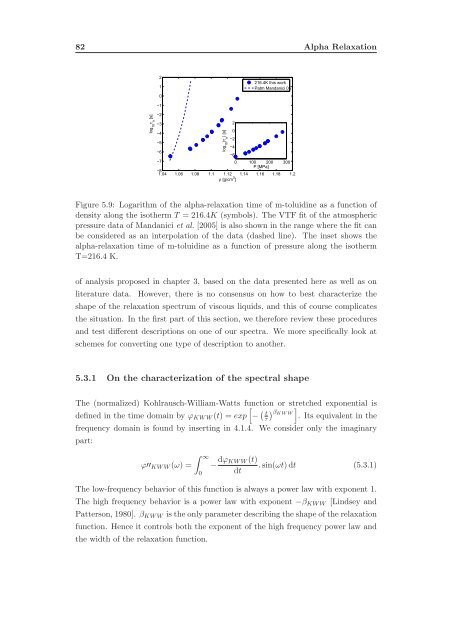Ph.D. thesis (pdf) - dirac
Ph.D. thesis (pdf) - dirac
Ph.D. thesis (pdf) - dirac
Create successful ePaper yourself
Turn your PDF publications into a flip-book with our unique Google optimized e-Paper software.
82 Alpha Relaxation<br />
2<br />
1<br />
0<br />
216.4K this work<br />
Patm Mandanici 05<br />
log 10<br />
τ α<br />
[s]<br />
−1<br />
−2<br />
−3<br />
−4<br />
−5<br />
−6<br />
log 10<br />
(τ α<br />
) [s]<br />
2<br />
0<br />
−2<br />
−4<br />
−6<br />
−7<br />
0 100 200 300<br />
P [MPa]<br />
−8<br />
1.04 1.06 1.08 1.1 1.12 1.14 1.16 1.18 1.2<br />
ρ [g/cm 3 ]<br />
Figure 5.9: Logarithm of the alpha-relaxation time of m-toluidine as a function of<br />
density along the isotherm T = 216.4K (symbols). The VTF fit of the atmospheric<br />
pressure data of Mandanici et al. [2005] is also shown in the range where the fit can<br />
be considered as an interpolation of the data (dashed line). The inset shows the<br />
alpha-relaxation time of m-toluidine as a function of pressure along the isotherm<br />
T=216.4 K.<br />
of analysis proposed in chapter 3, based on the data presented here as well as on<br />
literature data. However, there is no consensus on how to best characterize the<br />
shape of the relaxation spectrum of viscous liquids, and this of course complicates<br />
the situation. In the first part of this section, we therefore review these procedures<br />
and test different descriptions on one of our spectra. We more specifically look at<br />
schemes for converting one type of description to another.<br />
5.3.1 On the characterization of the spectral shape<br />
The (normalized) Kohlrausch-William-Watts function [ or stretched exponential is<br />
defined in the time domain by ϕ KWW (t) = exp − ( ) ]<br />
t βKWW<br />
τ<br />
. Its equivalent in the<br />
frequency domain is found by inserting in 4.1.4. We consider only the imaginary<br />
part:<br />
ϕ′′ KWW (ω) =<br />
∫ ∞<br />
0<br />
− dϕ KWW(t)<br />
. sin(ωt)dt (5.3.1)<br />
dt<br />
The low-frequency behavior of this function is always a power law with exponent 1.<br />
The high frequency behavior is a power law with exponent −β KWW [Lindsey and<br />
Patterson, 1980]. β KWW is the only parameter describing the shape of the relaxation<br />
function. Hence it controls both the exponent of the high frequency power law and<br />
the width of the relaxation function.

















